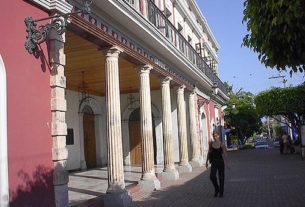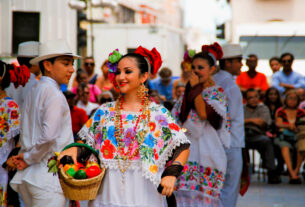Which village in Mexico celebrates the passing of the Old Year and the entrance of the New in the most unusual way? Almost certainly, the village of Santa Rosa Xochiac, just thirty minutes by car south-west of Mexico City, and still inside the Federal District. There are two churches in this village and, on December 31, a statue of the Virgin is carried in stately procession, brass band included, from her regular home in the small church, to her temporary “holiday-home” in the large one. The distance between the two churches is about two kilometers and, lest the Virgin be offended by her surroundings, the entire length of her route is elaborately decorated. Strung overhead, a variety of ingenious objects made of paper, plastic and straw, swing in the light breeze. Beneath the Virgin’s palanquin is laid an extraordinary carpet of colored sawdust, arranged into artistic and inventive patterns. No-one, not even the bearers of the palanquin, dares to step on this carpet until after the Virgin has passed by on her way to the village plaza.
The central part of the plaza has previously been turned into a giant, multicolored, sawdust carpet. Each year, the designs seek to outdo those of the year before in complexity and creativity. Floral patterns are often chosen – this is particularly appropriate since the village’s name derives from “place of flowers”. Each year, the designs take longer and longer to create and more expert hands are needed. When the Virgin arrives, an open-air mass brings the old year to a close.
The sawdust carpet of the New Year fiesta may seem like a tradition with roots far in the misty pre-Columbian past, but is actually less than 25 years old. It began when local community leaders visited Huamantla, Tlaxcala, for that village’s August 15th fiesta. They returned entranced by Huamantla’s famous flower-carpet, and convinced that Santa Rosa could do something similar.
From mid-December, tall, seasonally decorated, pine trees are temporarily installed in the small church; the church is one of the very few in Mexico where you can witness prehispanic Indian dances being performed inside a post-Conquest religious building. Once begun, the Christmas – New Year fiesta lasts for several days, with a full complement of games, entertainment, fireworks and fun.
Even though only 26.5 kilometers separate Santa Rosa Xochiac from Mexico City, in terms of lifestyles, they may as well be on different continents. Besides the New Year fiesta, the villagers also revel in their August fiesta in honour of Santa Rosa.
For a break from serious fiesta-watching, it is worth combining a trip to Santa Rosa with a visit to the Desierto de Los Leones National Park, about four kilometers away. In the middle of what was the country’s first National Park, established in 1917, is a lovely exconvent. It is easy to see why the Barefoot Carmelites chose this setting for their retreat, less easy to see why they went barefoot. The cool, crisp mountain air at this altitude (about 3,000 meters above sea level) and the huge, old, oak, pine and sacred fir trees are conducive to thinking about the sublime realities of another, higher, order. There is such a maze of tracks and paths crisscrossing the 1800-hectare park that it is easy to get lost, and not just in contemplation.
Adding to the freshness of this awesome forest are many cool springs and small streams. A profusion of seasonal wildflowers adds color to the dim light filtering through the trees. The Desierto de Los Leones National Park is an ideal place for camping, picnicking, or, for those too lazy to cook for themselves, sampling the delicious barbecued meat accompanied by blue-corn tortillas prepared at one of dozens of small food stands.
And how did this forest acquire the name “Desierto”? Because the constitution of the Carmelite order stipulated that they should have, in each of their provinces, “a house in the wilderness” (“una casa de Desierto”), in memory of Saint Elías, their order’s spiritual founder, who spend most of his life as a recluse on Mount Carmel in Israel.
The Barefoot Carmelites took vows of virtue, isolation, poverty and silence. To help them “dedicate their lives to prayer”, they spent prolonged periods of time in isolated hermitages, each of which had a prayer-room (oratorio), a small cell, and a fruit and flower garden, watered from a fountain. The hermitages were all within earshot of the convent’s bell.
In 1801, when the monks moved their home to Tenancingo, Edo. de México, Desierto de Los Leones became an “ex-convent”. Why “Leones” (= Lions)? The surrounding forest may well have harbored pumas or mountain lions, together with deer, rabbits and wolves, but, almost certainly, the origin of “De Leones” had nothing to do with the local wildlife. More likely, it came from the surname of a family of lawyers retained by the Carmelites in order to exercise their land rights more discreetly than would otherwise have been possible, the “Leones” pretending to be the owners as far as the public were concerned.
On the 15th of November of 1917, President Venustiano Carranza signed a decree making the area a National Park, the first officially protected area of this category in the country. Status as a National Park has not, unfortunately, prevented misuse of the area. For example, in 1981, a local community, San Mateo Tlaltenango, was given the right to fell trees. Illegal tree-felling and a plague caused by a (defoliant, boring) boring worm, have taken an enormous toll on the trees in the park. On the other hand, the park’s problems provided the focus for one of Mexico City’s more successful ecological protest movements which helped inspire other community environmental movements in other parts of the city.
Visitors to the convent today are often less impressed by the interior of the building with its museum-like atmosphere, subterranean passages, and a small cafeteria, than by the formal garden behind it.
Beyond the trees is a small, dark, chapel with a domed, brick ceiling and the most astonishing auditory qualities, a “bóveda de los secretos”, in which what is whispered into one corner is clearly audible in the opposite corner…
The Desierto de Los Leones park has two entrances. The first, clearly signed, is off the Toluca highway. The second is from San Angel, by following the Calzada al Desierto de Los Leones road which winds its way up the ridge, passing close to various small villages including Santa Rosa Xochiac. If you follow the Santa Fe road from central Mexico City, you will eventually merge with this second route near Santa Rosa Xochiac. The park is open daily from 6:00am to 5:00pm. The former convent can be visited from Tuesday to Sunday, 10:00 to 5:00.


